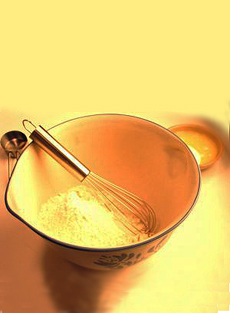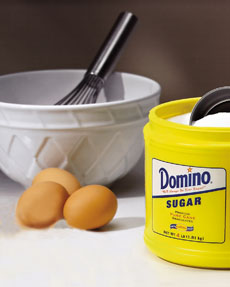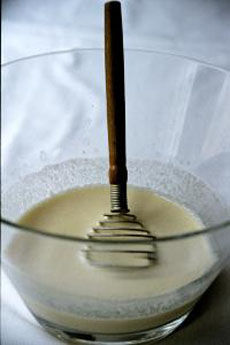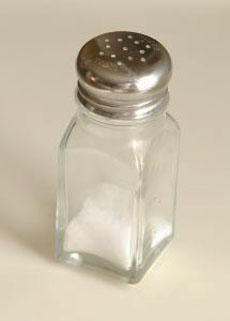

Batter up: The biggest challenge with most pancake mixes was a too-thin batter. Photo by Daniel West | SXC.
STEPHANIE ZONIS focuses on good foods and the people who produce them.
|
November 2009
|
 |
Best Pancake Mixes: Whole Grain & Multigrain
Page 3: How To Make Pancakes From Mix
This is Page 3 of a 6-page article, plus 18 pages of pancake reviews. Click the black links below to view other pages.
Get Ready To Make Pancakes
Go Tender, Not Tough
If you haven’t made pancakes from scratch before, there are elemental guidelines for doing so. You combine the dry ingredients in one bowl and the liquid ingredients in another. You then pour the liquid ingredients into the dry and blend so that the two form a batter. It’s important not to overmix the batter, as doing so can result in tough pancakes; in fact, pancake batter usually has some small lumps in it.
While a few of the mixes I tested called for placing the mix in a bowl and adding liquid ingredients to it, as is traditional, many simply instructed you to combine the mix and the liquid ingredients. A number of the mixes directed you to blend the liquid and dry ingredients until the batter was smooth.
- Note: If you add a dry mix to liquid ingredients (instead of the other way around) and/or mix a batter until it’s completely smooth, you can end up with an overblended batter, which might result in tough pancakes.
What You Get From A Mix
Mixes offer you the convenience of the dry ingredients, already weighed/measured and combined. You add a liquid (usually milk or buttermilk), fat (most often oil or melted butter; occasionally, the fat is optional) and frequently, egg.
- Sugar. Most mixes, but not all, are pre-sweetened, although several that I tested instruct you to add honey or sugar with the liquid ingredients.
EDITOR’S NOTE: There’s no obligation to add sugar or honey. Aside from the American obsession with adding sweeteners to everything, including meat (barbecue sauce and ketchup are mostly made of sweeteners), why add sugar to something you’ll be pouring more sugar—syrup, honey or jam—onto? On the other hand, if you don’t want to add a sweet topper, and eat your pancakes plain or with a pat of butter—like a quickbread—than a bit of sweetness in the batter may satisfy. We personally prefer our pancakes without any added sugar.
|
|

Think about holding the sugar if you plan to top your pancakes with syrup or another sweet condiment. Photo courtesy DominoSugar.com. |
- All-In-One. Another, newer type of mix incorporates liquid, fat and egg in dried form, in addition to the dry ingredients. In the trade, these are called “complete” or “JAW” (“just add water”) preparations.
Cooking Process
When cooking pancakes, if your griddle is not nonstick, you’ll need to grease it lightly before every batch of pancakes you cook.
- Preheat the griddle until a few drops of water thrown onto it sizzle and “dance” briefly before evaporating.
- Pancakes can be made small or large, according to your preferences, although this will also depend on your pancake batter (see “Batter Matters” below).
- Pancakes should be baked until they are puffy and bubble-filled on their uncooked surface; there will also be a ring of batter around the exterior edges that no longer looks raw, though this can be hard to spot.
- Knowing when your pancakes are nicely browned on the bottom surface can take a little practice. Once you flip pancakes, the second side always cooks and browns more quickly than the first, but it never looks as attractive. Most people prefer to flip the pancakes again, so that their prettier side is facing up on the serving plate.
- Always serve pancakes piping hot! If they cool before they get to the table, you can give them a 10-second zap in the microwave.
Issue #1: Batter Matters
In addition to good ingredients, good pancakes require an appropriate batter consistency—one that’s neither too thin nor too thick. Why?
Batter that is too thin will run too much on the griddle, causing pancakes that fuse into one another while they cook. On the other hand, batter that is too thick may result in pancakes that are doughy or gummy in the middle, since the batter won’t be cooked through when the pancakes are nicely browned on both sides.
While most mixes I tested wound up with appropriately small lumps in the batter, some had lumps that were too large. These tended to open up while the pancake was baking, exposing clumps of mix. These clumps were visible in the finished pancakes, but most didn’t seem to affect eating quality significantly. |
|

Photo courtesy SXC. |
Issue #2: The Sodium Blues
One of the big eye-openers in many of these mixes was the amount of sodium they contain. I was absolutely shocked by the quantity in some mixes, especially since you can’t always taste it. After a little investigation, however, it turns out that all the sodium in these mixes can’t be blamed entirely on manufacturers trying to sneak it in, because Americans are used to high sodium levels in their food for flavor (in addition to that sugar!).
Where else does the sodium come from?
Pancakes need a source of leavening. The preferred leavening sources for quick breads (and pancakes really are a form of quick bread) are those that any baker has in his or her kitchen: baking powder and/or baking soda. The can of baking powder I have lists sodium content at 60 mg for 1/8 teaspoon, while my box of baking soda contains 150 mg of sodium per 1/8 teaspoon. Table salt itself contains 590 mg of sodium per 1/4 teaspoon.
I learned to cook partly through recipes in the 1969 Betty Crocker’s Cookbook. This book contains a recipe for “Favorite Pancakes.” These are white flour pancakes with buttermilk, but the presence of whole grain flour(s) wouldn’t make much difference in the sodium levels. That recipe calls for, among other ingredients, 1 teaspoon of baking powder, 1/2 teaspoon of baking soda, 1/2 teaspoon of salt, 1 egg and 1 cup of buttermilk.
If you use an egg graded “large,” those five ingredients combined give you a disheartening 2,680 mg of sodium for a recipe that yields ten 4-inch pancakes, or 268 mg of sodium per pancake. And most of us eat more than just one pancake that’s four inches in diameter. |
|

Photo by Ramon Gonzalez | SXC. |
What To Do About The Sodium
If you’re trying to watch your sodium intake, check package labels carefully, and pay attention to the amount of mix in one serving, as serving sizes vary widely between brands.
- Remember that nutrition information may not be found on package labeling; if a manufacturer produces fewer than one hundred thousand of any product in one year using the same recipe, nutrition information on packaging is voluntary.
- If you don’t see the information, however, look on the website. If it’s not there, ask. Some manufacturers have such information, but simply choose not to put it on their packaging.
- If sodium is a serious concern, make your own pancake mix, so you can control the sodium level. Any basic cookbook or online search should give you a fundamental pancake recipe that can be altered regarding the type of flour used and the amount of salt added.
Go To The Article Index Above
Lifestyle Direct Direct, Inc. All rights reserved. Images are the copyright of their respective owners.

|







